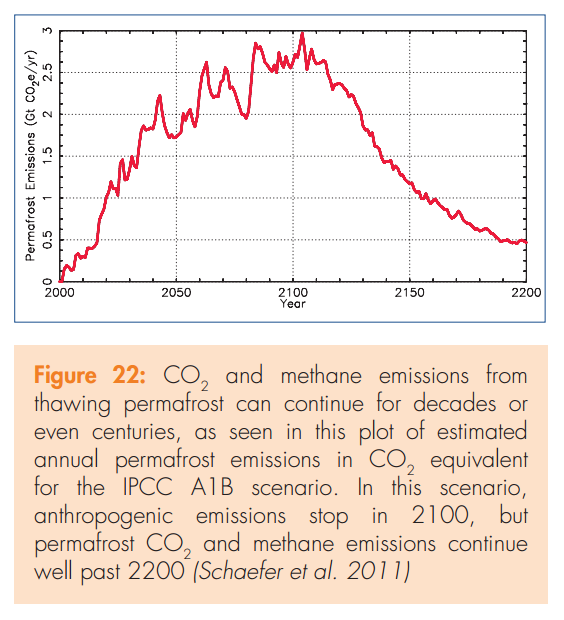UNEP today published a short report on the Policy Implications of Warming Permafrost. Although it contains a few estimates of the possible economic impacts in arctic communities, amounting to $3 – 6 billion, it does not contain any estimates of the far greater likely impacts around the world from the addition of many Megatonnes (Mt) of greenhouse gases to the atmosphere as the permafrost melts.

Fortunately, the report includes a graph (figure 22, shown left) which has the extra emissions that could result from the melting permafrost. They increase from about 300 Mt of CO2 equivalent today to 2500 Mt of CO2 equivalent in 2100.
Running these extra emissions through my PAGE09 integrated assessment model allows a first estimate of their extra impacts to be found: They would increase the global mean temperature by between 0.03 and 0.08 degC in 2100, and by between 0.05 and 0.12 degC by 2150 (10% – 90% intervals). This may not sound like much, but remember that this is on top of the 2.4 – 5.9 degC rise we expect by 2100 from the ‘standard’ business as usual emissions of greenhouse gases.
The melting permafrost adds to the possible inundation, storm surges, loss of agricultural output and ecosystem loss that we already expect climate change might bring in its wake. Perhaps most worrying is the extra boost it gives to the possibility of triggering a catastrophe such as the loss of the Greenland or West Antarctic ice sheets. Adding all these effects together gives a net present value of the extra impacts from melting permafrost over the next 200 years in the range of $2 – 27 trillion (10% – 90% interval), with a mean value of $14 trillion (ie $14,000 billion). This is very likely to be an underestimate, as the permafrost emissions I have used, following UNEP, assume anthropogenic greenhouse emissions stop in 2100.
UNEP’s main policy recommendation is to call for a Special Report on Permafrost Emissions. Extra impacts in the tens of trillions of dollars would suggest that we should do it soon.


J Bowers
It’s got to the point where one can simply think of oneself as being either pro-Holocene or pro-Eemian.